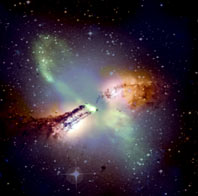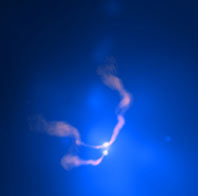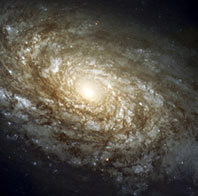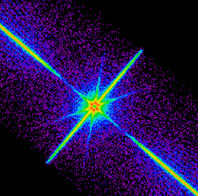Inside an EnigmaIf ever there was "a riddle wrapped in a mystery inside an enigma"—Winston Churchill's inimitable phrase—it is a black hole. In this spirited exchange, one man struggles to explain these deeply weird outer space entities while his interlocutor struggles just as hard to understand them. The first is astrophysicist Steven Ritz of NASA's Goddard Space Flight Center and the University of Maryland, and the second is Tom Lucas, producer of "Monster of the Milky Way." Will their conversation help you get a better fix on just what these mind-bendingly strange objects are? We hope so, but regardless we think you'll enjoy the ride. (You can also hear Ritz—and see what he looks like—in Black Holes Explained.) An object, yet also a spaceQ: So what is a black hole, Steve? Steve Ritz: A black hole is one of the most interesting and unusual ideas in all of science. At its simplest, it is a region of space-time from which nothing, including light, can escape. Once something has fallen into or is within that region, it can no longer come outside. Q: But what is it really? I don't get it. Ritz: You mean how could that happen? Or what is it? Q: I mean, is it a region? Is it an object? What is it? Ritz: Right, right. Well, let me explain, and you tell me whether you think it is an object or not. You are familiar with the idea that what goes up must come down. Imagine I have a tennis ball and I throw it up. It is going to go up, slow down, turn around, and come back down. The reason for that is gravity due to the Earth. Now, if I throw that tennis ball really fast, at something like seven miles a second, it will not come back. It will be able to escape [Earth's gravity into space]. Now, imagine that we are on a more massive or more dense planet, so we are in a region where gravity is much stronger than we are used to here. You throw something up, it is clearly going to turn around and come back down, so you have to launch it faster [if you want it to escape]. Imagine continuing to increase the strength of the gravity in that region of space and time, and the speed at which you have to launch something just to escape approaches or even exceeds the speed of light. At that point the escape velocity will be larger than the speed of light, and that means that nothing can escape. That means anything within that region will always stay within that region; it is confined there. Q: I thought light didn't have any mass. Ritz: Right, but what I said was something had to move at a certain speed to get— Q: But we are talking about gravity. Ritz: Right, okay. Let's talk for a minute about our understanding of gravity, since Einstein's general relativity is really at the heart of all this. Q: Okay. Ritz: Our picture of gravity now is that there is a very deep, intimate connection between matter and space and time, or space-time. Space-time is this thing that we all walk around in, and the curvature of space-time tells objects how to move. Again, if you imagine a tennis ball, if you let it go, it falls down. And that is a remarkable thing all by itself. Why is it that the tennis ball falls down? Well, everybody knows it's because the Earth is there. But think about it: how does the ball sitting up here in my hand know that the Earth is there? The Earth is not touching the ball, right? The ball is separate from the Earth, and yet you let it go and it knows to fall. The reason is that the matter of the Earth is actually warping space-time around the Earth. The ball is embedded in that space-time region, and that curvature tells the ball to move. Light moves along in space-time just like the tennis ball does, and so light senses that curvature too. The thing about a black hole is that the space-time is curved to such a degree that any projectile will fall back down into the region of the black hole. Does that make any sense? A thing, yet also notQ: Sort of. So what else defines a black hole—you've said it's very massive. Ritz: It is very strong gravity. Black holes can actually come in a wide variety of masses. How they are made will determine what the masses are, but in principle it is possible to have a black hole of almost any mass, as long as you can find a way to make it. You can have a black hole that's very, very light—a few grams—and its event horizon would be very, very small. [Editor's note: The event horizon is the invisible boundary surrounding a black hole within which the gravity is so strong that not even light can escape.] Or you can have a black hole that is incredibly massive, in which case its event horizon would be quite large. “Some people would say a black hole does have a surface, others would say it doesn't, and they'd both be right.” Q: I still don't get it. What is a black hole? Is it a thing? Is it a region? What is it? Ritz: It is enigmatic, because it represents the laws of physics in the most extreme environments that we can imagine. It is outside of our experience. We don't make black holes here on Earth, at least not yet, so we don't really have all the words for describing them, though we can use analogies to bring us at least most of the way there. One way you can think about a black hole is that it is an incredibly simple object. Looking from the outside, there are really only a very limited number of properties that describe a black hole. It has a total mass. The event horizon has a certain size, or there is a certain curvature associated with the hole. We know that the black hole can have a spin, just like the Earth has a spin. And in principle it can also have an electric charge. That's it. You can think of it as a fundamental particle that has a mass, a spin, and a charge—that's it. Q: Is it a particle then? Ritz: Well, it depends on your definition of what a particle is. Q: Is it a thing? Ritz: Is it a thing? Q: Is there something there that you could touch? Ritz: No, there isn't something there that you could touch. Perhaps that is one of the hardest things to understand about black holes. Some people would say a black hole does have a surface, others would say it doesn't, and they'd both be right. When something has a surface—a ball, somebody's face—you can actually touch it. When light bounces off my face, it hits your eyes, and that is how you know that I'm here. A black hole doesn't have any of those things. As I've said, when light approaches a black hole, it enters this region of the interior, the inside of the event horizon, and it never comes out again. So you can't see it in the way that we're used to seeing things, and there is not a surface that you could actually touch. On the other hand, there is a surface associated with the black hole and that is the event horizon. It is that demarcation region where if a light beam is aimed so that it travels on the outside of the event horizon, it can keep going; it can escape to infinity. But if the light goes inside of this imaginary surface—the event horizon—it won't come out. So it is an object in the sense that it has physical properties. It does exist. It is not an abstract concept; it is part of reality. But it's an object that is very different from objects we're used to thinking about. Q: Okay, but does it occupy a space? If you go inside the event horizon, which is sort of like a threshold but is not the thing itself, is there a thing in there that has mass? Ritz: Uh, no. Like an electron, and notQ: That is what people think. That is what I think. If it's there, it must be something! Ritz: You're thinking that there is an inside and an outside to it, and inside it looks like this room, let's say. If you imagine the ceiling and the walls as the event horizon, we are now inside the hole, and I know the walls are there but I can't step through them. That is not the right way to think about it. And the reason it's not, and the reason black holes are so enigmatic, is because space and time themselves are stretched, curved, changed, modified in ways that we don't experience day to day, because it is such an extreme environment. It is nothing like the way it is here on Earth. So to think even of the space-time volume inside the hole as being something of finite size is not really the right way to think about it. The simplest way to think about it, viewing the hole from outside, is that you could say it is an object, but it is an object that you can't easily just touch, because it doesn't have a physical surface. But it is an object that possesses attributes of mass, spin, and potentially also of electric charge. Think of it this way: what is an electron? An electron is the thing that runs through our wires. It is inside of us, in all of our atoms. It is the thing that makes the television work. But if I ask you what is an electron, if we probed deeper, you would come to these same sorts of questions. Q: I have no idea what an electron is. Ritz: Right. Well, you can think of an electron as a fundamental particle that possesses mass, spin, and electric charge. So if it is difficult to conceptualize regions of space-time, it's just fine to think about a black hole as a fundamental basic particle. Q: Is it the size of an electron? Ritz: Its size depends directly on its mass. We can define size as the radius of curvature of space-time at the event horizon—that sets the size of the thing. And that depends very much on the mass of the black hole. Nothing inside, yet also somethingQ: Okay, let me ask you this: what happens to something when it falls into a black hole? Like gas, or an electron, or a cow? Ritz: Right. Well, first of all, I will say that this is conjecture, because nobody has ever done the experiment, and physics and science, after all, are experimental enterprises. If we haven't done the experiment and done a measurement, it's something that is still speculative. What happens when a cow falls into a black hole depends a fair amount on the mass of the hole, and also, interestingly enough, on your observation point. If you were outside watching the cow fall in— “You are literally just torn apart. It is not a very pleasant thing to contemplate happening.” Q: Let's say you are going along with it. Ritz: Okay, if you are going along with it, when you pass the event horizon you don't even know it. It is not like suddenly everything goes bump and you say "Uh oh, I have reached the point of no return." You yourself can't really tell that you have reached the point of no return. The environment around the black hole is certainly not benign, typically because there is a lot of gas and other stuff falling in, and it tends to be very hot. But if it is just the hole, that is, if you have somehow cleared away all the astrophysical stuff around it so we are just getting at the properties of the hole itself, as you pass through the event horizon you don't really notice anything. You will notice that you are in free fall and so you will feel weightless, but as you get closer and closer toward where you are falling—let's say you are falling feet first—you will notice the force of gravity at your feet is much stronger than the force of gravity at your head. In other words, the farther you are away from the hole, the weaker the gravitational forces; the closer you are to the hole, the stronger the gravitational forces. Those so-called tidal effects get bigger and bigger as you get closer and closer to the hole. And as it becomes really extreme, you are torn apart. You are literally just torn apart. It is not a very pleasant thing to contemplate happening. There is no physical place in the middle like a hard core. It's not like the solid atomic nucleus at the center of an atom; it is nothing like that at all. The fact is we simply don't know what is going on at the center of a black hole. Formally it is what is called the singularity, which is really just a simple way of saying we are ignorant about it. We know that there is very likely physics at much higher energy scales than we have yet uncovered in any accelerator or in any experiment, and that that undoubtedly changes the laws of physics in those very extreme, high-energy environments. But if you just take basic general relativity, there is a singularity where everything goes to hell. All the numbers reach infinities; you get absurd results. And that is good, that is quite important, because it tells us this is something we need to understand. It tells us that there is a limit to our knowledge, and if you want to go and push the frontiers of our knowledge, this has a big sign that says "Dig Here." Q: So there is nothing in the middle then? No hard kernel, no core? Ritz: As far as we know, that is right. Q: So what is there? Is there a center? Ritz: Not that you could discern. Remember, at this point you are dead! Seriously, no, there isn't. It doesn't really work like that. By the way, I should point out that people have done theoretical studies of what would happen if you were to fall into a black hole, and if the hole is benign enough, if the difference in the force of gravity between your head and your feet as you pass through the event horizon isn't that big, you could, if you had a rocket ship, fire the engines and wander around the space-time that is formally inside the event horizon your whole life and live a perfectly happy existence. Stuff conserved, yet notQ: Sounds fun. Ritz: In fact, you wouldn't particularly notice that you are confined to anything at all. So it's not a particularly unusual or extreme environment, though you would never be able to communicate again with people outside the hole. People outside the hole wouldn't get any signals from you, so you would be cut off forever. Now, to have regions of space-time that are isolated from other regions poses all sorts of very interesting problems for theoretical physics. For example, remember I told you that you could think of a black hole as a fundamental particle with just a simple mass, spin, and perhaps charge? That presents an interesting problem, because there is all this information in the stuff that is falling into the hole—the many particles of particular types, right? These are things that are strictly conserved in all our laws of physics outside of the black hole, and they just disappear. They go down the drain of a black hole, and all that is left is our knowledge of what went in—just the mass, spin, and charge. That's it. That causes all sorts of problems for information theory, for our conservation laws. “To understand black holes you first have to understand why they are black and then understand why they are not black.” Q: Is the matter that falls in destroyed, or does it just change form, or what? What happens to it? Ritz: That again depends on the hole—the size of the hole, the region around the hole. So let's move this from a sort of abstract discussion to our actual universe, because one of the absolutely amazing things is that black holes not only exist as a prediction of our best theory of gravity—general relativity—but they actually seem to exist in nature, and not just as a sort of side show. They are all over the place. Again, it depends on their environment and their mass, but these black hole systems—the system of a black hole and its environment—are not benign places off all by themselves. Enormous frictional forces are at work as the gas and stuff fall in, and huge amounts of energy are released. They are very hot environments, and the matter and objects, as they're falling, would get destroyed even perhaps before they reach the event horizon just from collisions; things will be ground up into plasma even before they reach the event horizon. But certainly once something has fallen into the hole and as it approaches the region of the singularity, absolutely it has lost its identity. So in that sense it is destroyed. Now, the mass itself has not been lost. In other words, if you weighed the black hole by having something orbit around it so that you could tell the central gravitating mass, if a kilogram of stuff falls in, then the hole's mass does increase. So it is not completely lost, but it is certainly ground up into a much simpler form. Black, yet not blackQ: So are black holes black? Ritz: That's a great question. I think to understand black holes you first have to understand why they are black and then understand why they are not black. And both are true. Remember, they are enigmatic objects! Black holes all by themselves are black. If you had a black hole in isolation in space and if you were to shine a light on it, the light would basically just go in and not bounce out. So the hole would look strictly black. But nothing in the universe exists all by itself, and black holes are embedded in the rest of the universe; they have an environment around them. And not only does the environment interact with the black hole, but the black hole interacts with the environment. These systems can get quite complicated quite quickly, but the amounts of energy that can be released during the interactions between the environment and the black hole are absolutely spectacular. A black hole system can be incredibly bright, because huge amounts of energy come streaming out of them. Q: How much energy? What are you talking about? Ritz: Well, it depends on the black hole system. The most remarkable black holes in the universe that we know about are supermassive black holes. We now think these reside in the centers of most, if not all, galaxies. By supermassive I mean that they are millions to tens of billions of times as massive as our sun. (And the sun, I remind you, is roughly half a million times as massive as the Earth.) These are just incredibly massive objects, whose event horizons are each about the size of our solar system, and the amount of power that can come out of these systems as the stuff falls in is huge. Just to give you a feeling for it, if you took all the stars in an entire galaxy like our own, which is a typical galaxy, pumping out all of that power over all wavelengths of light, the power that can come out of one of these active galaxies just from the region around the black hole is about that same amount—just from that small region. These are things that can be seen all the way across the visible universe. They are incredibly bright, incredibly powerful engines. Q: Well, thanks, Steve. I sort of get what black holes are. I mean, I now know a lot about them and yet not much at all! But given their enigmatic nature, I guess that's fitting.
Ritz: You're quite welcome, and welcome to our
universe!
|

A supermassive black hole lies at the center of this turbulent mix of multimillion-degree gas, dust, and cold gas in the galaxy Centaurus A. 
A bubble of hot gas 800 light-years tall (pink arc in image) shoots out from a supermassive black hole in the heart of a galaxy about 50 million light-years from Earth. 
As two supermassive black holes spiral towards each other in this X-ray/radio composite image, ponytail-like jets of multimillion-degree gas whip out from them. 
Our own galaxy is thought to have a supermassive black hole at its center. Here, an infrared image of the Milky Way's core captured by NASA's Spitzer Space Telescope. 
This ring of dust will eventually be swallowed by a black hole the mass of three million of our suns, which lurks at the hub of the ring. 
Astrophysicists now believe that supermassive black holes may lie at the center of most, if not all, large galaxies. Here, a spiral galaxy about 60 million light-years from Earth, imaged by the Hubble Space Telescope. |
|
|
|
|
Interview conducted on January 5, 2006 by Tom Lucas, producer of "Monster of the Milky Way," and edited by Peter Tyson, editor in chief of NOVA online Monster of the Milky Way Home | Send Feedback | Image Credits | Support NOVA |
© | Created September 2006 |

